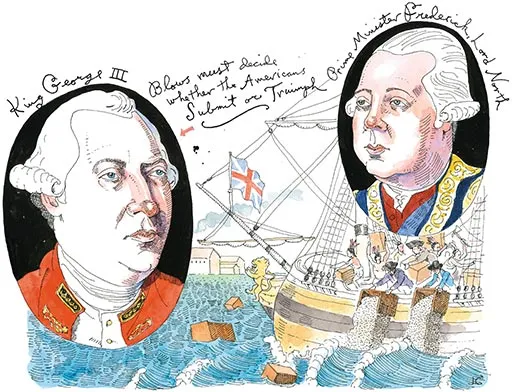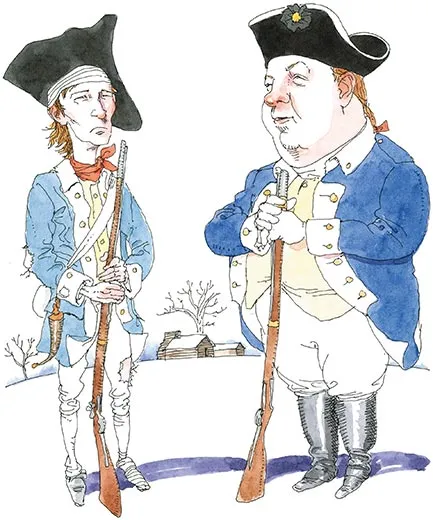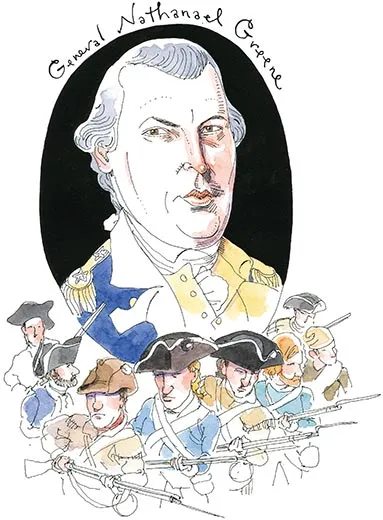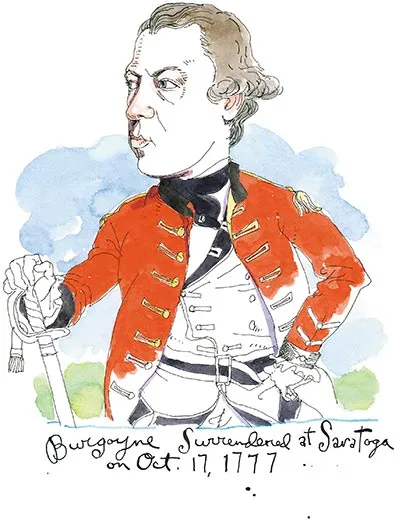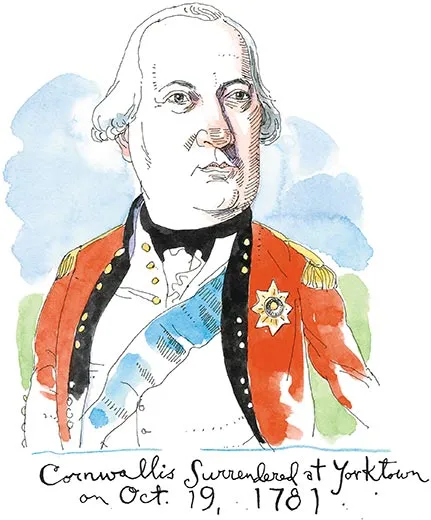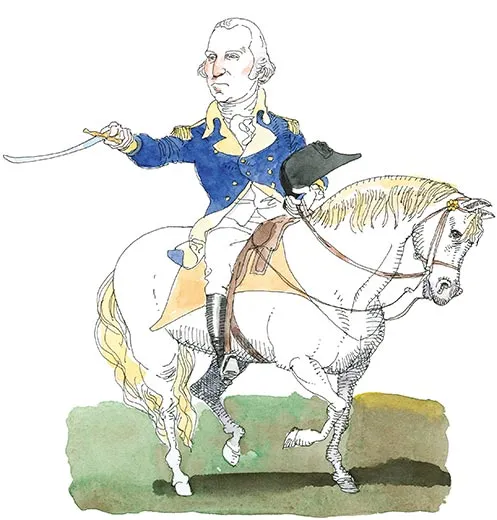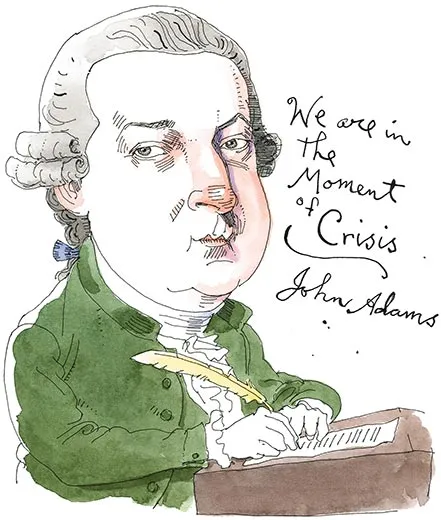Myths of the American Revolution
A noted historian debunks the conventional wisdom about America’s War of Independence
/https://tf-cmsv2-smithsonianmag-media.s3.amazonaws.com/filer/King-George-III-and-Lord-North-British-Leaders-631.jpg)
We think we know the Revolutionary War. After all, the American Revolution and the war that accompanied it not only determined the nation we would become but also continue to define who we are. The Declaration of Independence, the Midnight Ride, Valley Forge—the whole glorious chronicle of the colonists’ rebellion against tyranny is in the American DNA. Often it is the Revolution that is a child’s first encounter with history.
Yet much of what we know is not entirely true. Perhaps more than any defining moment in American history, the War of Independence is swathed in beliefs not borne out by the facts. Here, in order to form a more perfect understanding, the most significant myths of the Revolutionary War are reassessed.
I. Great Britain Did Not Know What It Was Getting Into
In the course of England’s long and unsuccessful attempt to crush the American Revolution, the myth arose that its government, under Prime Minister Frederick, Lord North, had acted in haste. Accusations circulating at the time—later to become conventional wisdom—held that the nation’s political leaders had failed to comprehend the gravity of the challenge.
Actually, the British cabinet, made up of nearly a score of ministers, first considered resorting to military might as early as January 1774, when word of the Boston Tea Party reached London. (Recall that on December 16, 1773, protesters had boarded British vessels in Boston Harbor and destroyed cargoes of tea, rather than pay a tax imposed by Parliament.) Contrary to popular belief both then and now, Lord North’s government did not respond impulsively to the news. Throughout early 1774, the prime minister and his cabinet engaged in lengthy debate on whether coercive actions would lead to war. A second question was considered as well: Could Britain win such a war?
By March 1774, North’s government had opted for punitive measures that fell short of declaring war. Parliament enacted the Coercive Acts—or Intolerable Acts, as Americans called them—and applied the legislation to Massachusetts alone, to punish the colony for its provocative act. Britain’s principal action was to close Boston Harbor until the tea had been paid for. England also installed Gen. Thomas Gage, commander of the British Army in America, as governor of the colony. Politicians in London chose to heed the counsel of Gage, who opined that the colonists would “be lyons whilst we are lambs but if we take the resolute part they will be very meek.”
Britain, of course, miscalculated hugely. In September 1774, colonists convened the First Continental Congress in Philadelphia; the members voted to embargo British commerce until all British taxes and the Coercive Acts were repealed. News of that vote reached London in December. A second round of deliberations within North’s ministry ensued for nearly six weeks.
Throughout its deliberations, North’s government agreed on one point: the Americans would pose little challenge in the event of war. The Americans had neither a standing army nor a navy; few among them were experienced officers. Britain possessed a professional army and the world’s greatest navy. Furthermore, the colonists had virtually no history of cooperating with one another, even in the face of danger. In addition, many in the cabinet were swayed by disparaging assessments of American soldiers leveled by British officers in earlier wars. For instance, during the French and Indian War (1754-63), Brig. Gen. James Wolfe had described America’s soldiers as “cowardly dogs.” Henry Ellis, the royal governor of Georgia, nearly simultaneously asserted that the colonists were a “poor species of fighting men” given to “a want of bravery.”
Still, as debate continued, skeptics—especially within Britain’s army and navy—raised troubling questions. Could the Royal Navy blockade the 1,000-mile-long American coast? Couldn’t two million free colonists muster a force of 100,000 or so citizen-soldiers, nearly four times the size of Britain’s army in 1775? Might not an American army of this size replace its losses more easily than Britain? Was it possible to supply an army operating 3,000 miles from home? Could Britain subdue a rebellion across 13 colonies in an area some six times the size of England? Could the British Army operate deep in America’s interior, far from coastal supply bases? Would a protracted war bankrupt Britain? Would France and Spain, England’s age-old enemies, aid American rebels? Was Britain risking starting a broader war?
After the Continental Congress convened, King George III told his ministers that “blows must decide” whether the Americans “submit or triumph.”
North’s government agreed. To back down, the ministers believed, would be to lose the colonies. Confident of Britain’s overwhelming military superiority and hopeful that colonial resistance would collapse after one or two humiliating defeats, they chose war. The Earl of Dartmouth, who was the American Secretary, ordered General Gage to use “a vigorous Exertion of...Force” to crush the rebellion in Massachusetts. Resistance from the Bay Colony, Dartmouth added, “cannot be very formidable.”
II. Americans Of All Stripes Took Up Arms Out Of Patriotism
The term “spirit of ‘76” refers to the colonists’ patriotic zeal and has always seemed synonymous with the idea that every able-bodied male colonist resolutely served, and suffered, throughout the eight-year war.
To be sure, the initial rally to arms was impressive. When the British Army marched out of Boston on April 19, 1775, messengers on horseback, including Boston silversmith Paul Revere, fanned out across New England to raise the alarm. Summoned by the feverish pealing of church bells, militiamen from countless hamlets hurried toward Concord, Massachusetts, where the British regulars planned to destroy a rebel arsenal. Thousands of militiamen arrived in time to fight; 89 men from 23 towns in Massachusetts were killed or wounded on that first day of war, April 19, 1775. By the next morning, Massachusetts had 12 regiments in the field. Connecticut soon mobilized a force of 6,000, one-quarter of its military-age men. Within a week, 16,000 men from the four New England colonies formed a siege army outside British-occupied Boston. In June, the Continental Congress took over the New England army, creating a national force, the Continental Army. Thereafter, men throughout America took up arms. It seemed to the British regulars that every able-bodied American male had become a soldier.
But as the colonists discovered how difficult and dangerous military service could be, enthusiasm waned. Many men preferred to remain home, in the safety of what Gen. George Washington described as their “Chimney Corner.” Early in the war, Washington wrote that he despaired of “compleating the army by Voluntary Inlistments.” Mindful that volunteers had rushed to enlist when hostilities began, Washington predicted that “after the first emotions are over,” those who were willing to serve from a belief in the “goodness of the cause” would amount to little more than “a drop in the Ocean.” He was correct. As 1776 progressed, many colonies were compelled to entice soldiers with offers of cash bounties, clothing, blankets and extended furloughs or enlistments shorter than the one-year term of service established by Congress.
The following year, when Congress mandated that men who enlisted must sign on for three years or the duration of the conflict, whichever came first, offers of cash and land bounties became an absolute necessity. The states and the army also turned to slick-tongued recruiters to round up volunteers. General Washington had urged conscription, stating that “the Government must have recourse to coercive measures.” In April 1777, Congress recommended a draft to the states. By the end of 1778, most states were conscripting men when Congress’ voluntary enlistment quotas were not met.
Moreover, beginning in 1778, the New England states, and eventually all Northern states, enlisted African-Americans, a practice that Congress had initially forbidden. Ultimately, some 5,000 blacks bore arms for the United States, approximately 5 percent of the total number of men who served in the Continental Army. The African-American soldiers made an important contribution to America’s ultimate victory. In 1781, Baron Ludwig von Closen, a veteran officer in the French Army, remarked that the “best [regiment] under arms” in the Continental Army was one in which 75 percent of the soldiers were African-Americans.
Longer enlistments radically changed the composition of the Army. Washington’s troops in 1775-76 had represented a cross section of the free male population. But few who owned farms were willing to serve for the duration, fearing loss of their property if years passed without producing revenue from which to pay taxes. After 1777, the average Continental soldier was young, single, propertyless, poor and in many cases an outright pauper. In some states, such as Pennsylvania, up to one in four soldiers was an impoverished recent immigrant. Patriotism aside, cash and land bounties offered an unprecedented chance for economic mobility for these men. Joseph Plumb Martin of Milford, Connecticut, acknowledged that he had enlisted for the money. Later, he would recollect the calculation he had made at the time: “As I must go, I might as well endeavor to get as much for my skin as I could.” For three-quarters of the war, few middle-class Americans bore arms in the Continental Army, although thousands did serve in militias.
III. Continental Soldiers Were Always Ragged And Hungry
Accounts of shoeless continental army soldiers leaving bloody footprints in the snow or going hungry in a land of abundance are all too accurate. Take, for example, the experience of Connecticut’s Private Martin. While serving with the Eighth Connecticut Continental Regiment in the autumn of 1776, Martin went for days with little more to eat than a handful of chestnuts and, at one point, a portion of roast sheep’s head, remnants of a meal prepared for those he sarcastically referred to as his “gentleman officers.” Ebenezer Wild, a Massachusetts soldier who served at Valley Forge in the terrible winter of 1777-78, would recall that he subsisted for days on “a leg of nothing.” One of his comrades, Dr. Albigence Waldo, a Continental Army surgeon, later reported that many men survived largely on what were known as fire cakes (flour and water baked over coals). One soldier, Waldo wrote, complained that his “glutted Gutts are turned to Pasteboard.” The Army’s supply system, imperfect at best, at times broke down altogether; the result was misery and want.
But that was not always the case. So much heavy clothing arrived from France at the beginning of the winter in 1779 that Washington was compelled to locate storage facilities for his surplus.
In a long war during which American soldiers were posted from upper New York to lower Georgia, conditions faced by the troops varied widely. For instance, at the same time that Washington’s siege army at Boston in 1776 was well supplied, many American soldiers, engaged in the failed invasion of Quebec staged from Fort Ticonderoga in New York, endured near starvation. While one soldier in seven was dying from hunger and disease at Valley Forge, young Private Martin, stationed only a few miles away in Downingtown, Pennsylvania, was assigned to patrols that foraged daily for army provisions. “We had very good provisions all winter,” he would write, adding that he had lived in “a snug room.” In the spring after Valley Forge, he encountered one of his former officers. “Where have you been this winter?” inquired the officer. “Why you are as fat as a pig.”
IV. The Militia Was Useless
The nation’s first settlers adopted the British militia system, which required all able-bodied men between 16 and 60 to bear arms. Some 100,000 men served in the Continental Army during the Revolutionary War. Probably twice that number soldiered as militiamen, for the most part defending the home front, functioning as a police force and occasionally engaging in enemy surveillance. If a militia company was summoned to active duty and sent to the front lines to augment the Continentals, it usually remained mobilized for no more than 90 days.
Some Americans emerged from the war convinced that the militia had been largely ineffective. No one did more to sully its reputation than General Washington, who insisted that a decision to “place any dependence on Militia is assuredly resting on a broken staff.”
Militiamen were older, on average, than the Continental soldiers and received only perfunctory training; few had experienced combat. Washington complained that militiamen had failed to exhibit “a brave & manly opposition” in the battles of 1776 on Long Island and in Manhattan. At Camden, South Carolina, in August 1780, militiamen panicked in the face of advancing redcoats. Throwing down their weapons and running for safety, they were responsible for one of the worst defeats of the war.
Yet in 1775, militiamen had fought with surpassing bravery along the Concord Road and at Bunker Hill. Nearly 40 percent of soldiers serving under Washington in his crucial Christmas night victory at Trenton in 1776 were militiamen. In New York state, half the American force in the vital Saratoga campaign of 1777 consisted of militiamen. They also contributed substantially to American victories at Kings Mountain, South Carolina, in 1780 and Cowpens, South Carolina, the following year. In March 1781, Gen. Nathanael Greene adroitly deployed his militiamen in the Battle of Guilford Courthouse (fought near present-day Greensboro, North Carolina). In that engagement, he inflicted such devastating losses on the British that they gave up the fight for North Carolina.
The militia had its shortcomings, to be sure, but America could not have won the war without it. As a British general, Earl Cornwallis, wryly put it in a letter in 1781, “I will not say much in praise of the militia, but the list of British officers and soldiers killed and wounded by them...proves but too fatally they are not wholly contemptible.”
V. Saratoga Was The War’s Turning Point
On October 17, 1777, British Gen. John Burgoyne surrendered 5,895 men to American forces outside Saratoga, New York. Those losses, combined with the 1,300 men killed, wounded and captured during the preceding five months of Burgoyne’s campaign to reach Albany in upstate New York, amounted to nearly one-quarter of those serving under the British flag in America in 1777.
The defeat persuaded France to form a military alliance with the United States. Previously, the French, even though they believed that London would be fatally weakened by the loss of its American colonies, had not wished to take a chance on backing the new American nation. General Washington, who rarely made optimistic pronouncements, exulted that France’s entry into the war in February 1778 had introduced “a most happy tone to all our affairs,” as it “must put the Independency of America out of all manner of dispute.”
But Saratoga was not the turning point of the war. Protracted conflicts—the Revolutionary War was America’s longest military engagement until Vietnam nearly 200 years later—are seldom defined by a single decisive event. In addition to Saratoga, four other key moments can be identified. The first was the combined effect of victories in the fighting along the Concord Road on April 19, 1775, and at Bunker Hill near Boston two months later, on June 17. Many colonists had shared Lord North’s belief that American citizen-soldiers could not stand up to British regulars. But in those two engagements, fought in the first 60 days of the war, American soldiers—all militiamen—inflicted huge casualties. The British lost nearly 1,500 men in those encounters, three times the American toll. Without the psychological benefits of those battles, it is debatable whether a viable Continental Army could have been raised in that first year of war or whether public morale would have withstood the terrible defeats of 1776.
Between August and November of 1776, Washington’s army was driven from Long Island, New York City proper and the rest of Manhattan Island, with some 5,000 men killed, wounded and captured. But at Trenton in late December 1776, Washington achieved a great victory, destroying a Hessian force of nearly 1,000 men; a week later, on January 3, he defeated a British force at Princeton, New Jersey. Washington’s stunning triumphs, which revived hopes of victory and permitted recruitment in 1777, were a second turning point.
A third turning point occurred when Congress abandoned one-year enlistments and transformed the Continental Army into a standing army, made up of regulars who volunteered—or were conscripted—for long-term service. A standing army was contrary to American tradition and was viewed as unacceptable by citizens who understood that history was filled with instances of generals who had used their armies to gain dictatorial powers. Among the critics was Massachusetts’ John Adams, then a delegate to the Second Continental Congress. In 1775, he wrote that he feared a standing army would become an “armed monster” composed of the “meanest, idlest, most intemperate and worthless” men. By autumn, 1776, Adams had changed his view, remarking that unless the length of enlistment was extended, “our inevitable destruction will be the Consequence.” At last, Washington would get the army he had wanted from the outset; its soldiers would be better trained, better disciplined and more experienced than the men who had served in 1775-76.
The campaign that unfolded in the South during 1780 and 1781 was the final turning point of the conflict. After failing to crush the rebellion in New England and the mid-Atlantic states, the British turned their attention in 1778 to the South, hoping to retake Georgia, South Carolina, North Carolina and Virginia. At first the Southern Strategy, as the British termed the initiative, achieved spectacular results. Within 20 months, the redcoats had wiped out three American armies, retaken Savannah and Charleston, occupied a substantial portion of the South Carolina backcountry, and killed, wounded or captured 7,000 American soldiers, nearly equaling the British losses at Saratoga. Lord George Germain, Britain’s American Secretary after 1775, declared that the Southern victories augured a “speedy and happy termination of the American war.”
But the colonists were not broken. In mid-1780, organized partisan bands, composed largely of guerrilla fighters, struck from within South Carolina’s swamps and tangled forests to ambush redcoat supply trains and patrols. By summer’s end, the British high command acknowledged that South Carolina, a colony they had recently declared pacified, was “in an absolute state of rebellion.” Worse was yet to come. In October 1780, rebel militia and backcountry volunteers destroyed an army of more than 1,000 Loyalists at Kings Mountain in South Carolina. After that rout, Cornwallis found it nearly impossible to persuade Loyalists to join the cause.
In January 1781, Cornwallis marched an army of more than 4,000 men to North Carolina, hoping to cut supply routes that sustained partisans farther south. In battles at Cowpens and Guilford Courthouse and in an exhausting pursuit of the Army under Gen. Nathanael Greene, Cornwallis lost some 1,700 men, nearly 40 percent of the troops under his command at the outset of the North Carolina campaign. In April 1781, despairing of crushing the insurgency in the Carolinas, he took his army into Virginia, where he hoped to sever supply routes linking the upper and lower South. It was a fateful decision, as it put Cornwallis on a course that would lead that autumn to disaster at Yorktown, where he was trapped and compelled to surrender more than 8,000 men on October 19, 1781. The next day, General Washington informed the Continental Army that “the glorious event” would send “general Joy [to] every breast” in America. Across the sea, Lord North reacted to the news as if he had “taken a ball in the breast,” reported the messenger who delivered the bad tidings. “O God,” the prime minister exclaimed, “it is all over.”
VI. General Washington Was A Brilliant Tactician And Strategist
Among the hundreds of eulogies delivered after the death of George Washington in 1799, Timothy Dwight, president of Yale College, averred that the general’s military greatness consisted principally in his “formation of extensive and masterly plans” and a “watchful seizure of every advantage.” It was the prevailing view and one that has been embraced by many historians.
In fact, Washington’s missteps revealed failings as a strategist. No one understood his limitations better than Washington himself who, on the eve of the New York campaign in 1776, confessed to Congress his “want of experience to move on a large scale” and his “limited and contracted knowledge . . . in Military Matters.”
In August 1776, the Continental Army was routed in its first test on Long Island in part because Washington failed to properly reconnoiter and he attempted to defend too large an area for the size of his army. To some extent, Washington’s nearly fatal inability to make rapid decisions resulted in the November losses of Fort Washington on Manhattan Island and Fort Lee in New Jersey, defeats that cost the colonists more than one-quarter of the army’s soldiers and precious weaponry and military stores. Washington did not take the blame for what had gone wrong. Instead, he advised Congress of his “want of confidence in the Generality of the Troops.”
In the fall of 1777, when Gen. William Howe invaded Pennsylvania, Washington committed his entire army in an attempt to prevent the loss of Philadelphia. During the Battle of Brandywine, in September, he once again froze with indecision. For nearly two hours information poured into headquarters that the British were attempting a flanking maneuver—a move that would, if successful, entrap much of the Continental Army—and Washington failed to respond. At day’s end, a British sergeant accurately perceived that Washington had “escaped a total overthrow, that must have been the consequence of an hours more daylight.”
Later, Washington was painfully slow to grasp the significance of the war in the Southern states. For the most part, he committed troops to that theater only when Congress ordered him to do so. By then, it was too late to prevent the surrender of Charleston in May 1780 and the subsequent losses among American troops in the South. Washington also failed to see the potential of a campaign against the British in Virginia in 1780 and 1781, prompting Comte de Rochambeau, commander of the French Army in America, to write despairingly that the American general “did not conceive the affair of the south to be such urgency.” Indeed, Rochambeau, who took action without Washington’s knowledge, conceived the Virginia campaign that resulted in the war’s decisive encounter, the siege of Yorktown in the autumn of 1781.
Much of the war’s decision-making was hidden from the public. Not even Congress was aware that the French, not Washington, had formulated the strategy that led to America’s triumph. During Washington’s presidency, the American pamphleteer Thomas Paine, then living in France, revealed much of what had occurred. In 1796 Paine published a “Letter to George Washington,” in which he claimed that most of General Washington’s supposed achievements were “fraudulent.” “You slept away your time in the field” after 1778, Paine charged, arguing that Gens. Horatio Gates and Greene were more responsible for America’s victory than Washington.
There was some truth to Paine’s acid comments, but his indictment failed to recognize that one can be a great military leader without being a gifted tactician or strategist. Washington’s character, judgment, industry and meticulous habits, as well as his political and diplomatic skills, set him apart from others. In the final analysis, he was the proper choice to serve as commander of the Continental Army.
VII. Great Britain Could Never Have Won The War
Once the revolutionary war was lost, some in Britain argued that it had been unwinnable. For generals and admirals who were defending their reputations, and for patriots who found it painful to acknowledge defeat, the concept of foreordained failure was alluring. Nothing could have been done, or so the argument went, to have altered the outcome. Lord North was condemned, not for having lost the war, but for having led his country into a conflict in which victory was impossible.
In reality, Britain might well have won the war. The battle for New York in 1776 gave England an excellent opportunity for a decisive victory. France had not yet allied with the Americans. Washington and most of his lieutenants were rank amateurs. Continental Army soldiers could not have been more untried. On Long Island, in New York City and in upper Manhattan, on Harlem Heights, Gen. William Howe trapped much of the American Army and might have administered a fatal blow. Cornered in the hills of Harlem, even Washington admitted that if Howe attacked, the Continental Army would be “cut off” and faced with the choice of fighting its way out “under every disadvantage” or being starved into submission. But the excessively cautious Howe was slow to act, ultimately allowing Washington to slip away.
Britain still might have prevailed in 1777. London had formulated a sound strategy that called for Howe, with his large force, which included a naval arm, to advance up the Hudson River and rendezvous at Albany with General Burgoyne, who was to invade New York from Canada. Britain’s objective was to cut New England off from the other nine states by taking the Hudson. When the rebels did engage—the thinking went—they would face a giant British pincer maneuver that would doom them to catastrophic losses. Though the operation offered the prospect of decisive victory, Howe scuttled it. Believing that Burgoyne needed no assistance and obsessed by a desire to capture Philadelphia—home of the Continental Congress—Howe opted to move against Pennsylvania instead. He took Philadelphia, but he accomplished little by his action. Meanwhile, Burgoyne suffered total defeat at Saratoga.
Most historians have maintained that Britain had no hope of victory after 1777, but that assumption constitutes another myth of this war. Twenty-four months into its Southern Strategy, Britain was close to reclaiming substantial territory within its once-vast American empire. Royal authority had been restored in Georgia, and much of South Carolina was occupied by the British.
As 1781 dawned, Washington warned that his army was “exhausted” and the citizenry “discontented.” John Adams believed that France, faced with mounting debts and having failed to win a single victory in the American theater, would not remain in the war beyond 1781. “We are in the Moment of Crisis,” he wrote. Rochambeau feared that 1781 would see the “last struggle of an expiring patriotism.” Both Washington and Adams assumed that unless the United States and France scored a decisive victory in 1781, the outcome of the war would be determined at a conference of Europe’s great powers.
Stalemated wars often conclude with belligerents retaining what they possessed at the moment an armistice is reached. Had the outcome been determined by a European peace conference, Britain would likely have retained Canada, the trans-Appalachian West, part of present-day Maine, New York City and Long Island, Georgia and much of South Carolina, Florida (acquired from Spain in a previous war) and several Caribbean islands. To keep this great empire, which would have encircled the tiny United States, Britain had only to avoid decisive losses in 1781.Yet Cornwallis’ stunning defeat at Yorktown in October cost Britain everything but Canada.
The Treaty of Paris, signed on September 3, 1783, ratified the American victory and recognized the existence of the new United States. General Washington, addressing a gathering of soldiers at West Point, told the men that they had secured America’s “independence and sovereignty.” The new nation, he said, faced “enlarged prospects of happiness,” adding that all free Americans could enjoy “personal independence.” The passage of time would demonstrate that Washington, far from creating yet another myth surrounding the outcome of the war, had voiced the real promise of the new nation.
Historian John Ferling’s most recent book is The Ascent of George Washington: The Hidden Political Genius of an American Icon. Illustrator Joe Ciardiello lives in Milford, New Jersey.
CORRECTION: An earlier version of this story placed Kings Mountain in North Carolina instead of South Carolina. We regret the error.

